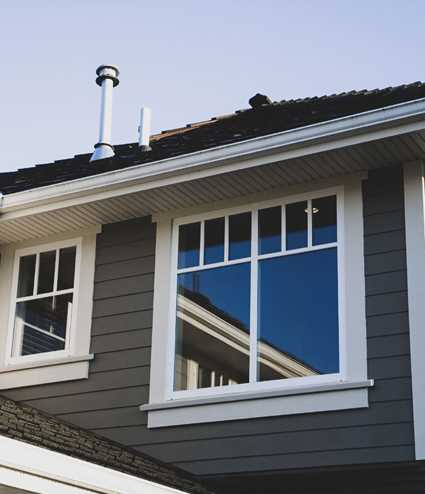Sidelites and transoms are architectural features that enhance the aesthetics and functionality of doors and your home. These elements not only add beauty to a structure but also improve natural light flow and create a welcoming atmosphere.
At Thermal King, we want you to understand all components of your entry door replacement. We’ve helped thousands of Omaha and Kansas City homeowners find the perfect doors for their home and budget.
This guide will explore the various aspects of sidelites and transoms, including their definitions, benefits, design options, and installation considerations.
Understanding Sidelites
Sidelites are vertical windows positioned on one or both sides of a door. They serve to frame the entrance, offering a glimpse of the interior while allowing natural light to flood the entryway. Sidelites can be found in residential and commercial buildings, providing both aesthetic appeal and practical benefits.
Benefits of Sidelites
The inclusion of sidelites in a doorway design offers several advantages. Firstly, they significantly enhance natural light penetration, making entryways feel more spacious and inviting. This is particularly beneficial in darker hallways or areas where artificial lighting may be insufficient.
Additionally, sidelites can improve visibility and security. They allow occupants to see who is at the door without opening it, providing peace of mind. Furthermore, sidelites can contribute to the overall architectural style of a building, complementing its design and enhancing curb appeal.
Design Options for Sidelites
When it comes to sidelites, there are various design options to consider. They can be fixed or operable, with the latter allowing for ventilation. Fixed sidelites are often used for their sleek appearance and ability to maximize light. On the other hand, operable sidelites can be opened to let in fresh air, making them a practical choice for warmer climates.
Moreover, sidelites can be customized in terms of size, shape, and glass type. Common shapes include rectangular, arched, and even custom designs that align with the overall architectural theme. Glass options range from clear and frosted to stained or decorative glass, allowing homeowners to express their personal style.
In addition to their aesthetic versatility, sidelites can also be designed with energy efficiency in mind. Many modern sidelites incorporate double or triple glazing, which helps to insulate the home and reduce energy costs. This is particularly important in regions with extreme weather conditions, where maintaining a comfortable indoor temperature is essential. Furthermore, the use of low-emissivity (Low-E) glass can minimize UV exposure, protecting interior furnishings from fading while still allowing ample light to enter.
Another interesting aspect of sidelites is their ability to enhance the overall flow of a space. By strategically placing sidelites, homeowners can create a seamless transition between the indoors and outdoors, blurring the lines and making the entryway feel like an extension of the living area. This design approach not only boosts the visual appeal but also encourages a more inviting atmosphere for guests and residents alike, fostering a sense of connection with the surrounding environment.
Exploring Transoms
Transoms are horizontal windows situated above doors or windows. Like sidelites, transoms serve to enhance natural light and add visual interest to a space. They can be fixed or operable, depending on the desired functionality and design.
Advantages of Transoms
Transoms offer several benefits that make them a popular choice in modern architecture. One of the primary advantages is the ability to increase natural light without compromising privacy. They allow light to enter a room while maintaining a barrier between the interior and exterior, making them ideal for bathrooms or bedrooms.
Additionally, transoms can create a sense of openness and height in a space. By drawing the eye upward, they can make rooms feel larger and more airy. This effect is particularly valuable in smaller homes or rooms with low ceilings. The strategic placement of transoms can also enhance the overall flow of a home, guiding light from one area to another and creating a seamless transition between spaces. This can be especially beneficial in open-concept designs where maintaining a sense of connection while delineating areas is key.
Design Variations for Transoms
Transoms come in various styles and designs, allowing for versatility in architectural applications. They can be designed to match the style of the door or window they accompany, ensuring a cohesive look. Options include traditional rectangular transoms, rounded designs, or even more elaborate shapes that add character to a building.
Glass choices for transoms also vary widely. Clear glass is a common option, but frosted or decorative glass can add a unique touch. Some homeowners opt for transoms with built-in blinds or shades, providing additional control over light and privacy. Furthermore, the framing of transoms can be customized to complement the architectural style of the home; whether it’s a sleek modern frame or an ornate traditional design, the right choice can enhance the overall aesthetic. In addition, transoms can be paired with various materials, such as wood, metal, or even composite materials, allowing for a range of finishes that can suit both contemporary and classic homes. This flexibility in design ensures that transoms can be a striking feature that not only serves a functional purpose but also elevates the beauty of a space.
Combining Sidelites and Transoms
When used together, sidelites and transoms can create a stunning entrance that maximizes light and enhances architectural appeal of your home. This combination allows for a cohesive design that draws attention and creates a welcoming atmosphere.
Architectural Harmony
Combining sidelites and transoms can achieve architectural harmony, especially in traditional or classic designs. For instance, a grand front door flanked by sidelites and topped with a transom creates a balanced and elegant look. This arrangement not only enhances the entrance but also complements the overall style of the home.
Furthermore, the use of consistent materials and finishes across sidelites and transoms can unify the design. Whether opting for wood, fiberglass, or metal frames, maintaining a consistent aesthetic can elevate the overall appearance of the entryway.
Practical Considerations
While the aesthetic benefits of sidelites and transoms are significant, practical considerations must also be taken into account. Energy efficiency is a crucial factor, especially in regions with extreme weather conditions. Selecting energy-efficient glass and proper framing can help regulate indoor temperatures and reduce energy costs.
Additionally, homeowners should consider the maintenance requirements of sidelites and transoms. Depending on the materials used, some options may require more upkeep than others. For example, wood frames may need regular painting or staining, while vinyl or fiberglass options typically require less maintenance.
Final Thoughts – Sidelites and Transoms
Sidelites and transoms are more than just decorative elements; they are functional features that enhance the beauty and practicality of a space. By understanding their benefits, design options, and installation considerations, homeowners can make informed decisions that elevate their property’s appeal.
Whether opting for a classic design or a modern interpretation, sidelites and transoms can transform an entry way, creating a warm and inviting atmosphere. With proper maintenance and care, these architectural features can provide lasting value and enjoyment for years to come.
If you’re ready to replace your entry door – including sidelites and transoms, contact the experts at Thermal King today!




